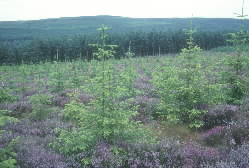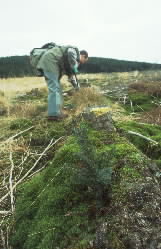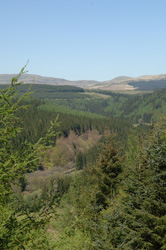Summary
Summary
 This research project aims to underpin the delivery of a robust woodland resource through the development of tools and advice that assist practical management decisions across all aspects of the tree establishment process.
This research project aims to underpin the delivery of a robust woodland resource through the development of tools and advice that assist practical management decisions across all aspects of the tree establishment process.
Based on an understanding of the physiological processes that determine growth and survival, and of the response of seedling trees to environmental stimuli, this research addresses the impacts of silvicultural decisions from nursery production to canopy closure, with a particular focus on upland sites and includes:
- Investigation of tree nursery production systems
- Development of plant quality assessment tools
- Provision of best practice advice to promote sustainable site establishment practices
- Research into novel tree establishment techniques.
Research objectives
Investigations into:
- Techniques for quality broadleaf woodland establishment for timber production on former conifer sites.
- Systems for upland PAWS restoration and farm woodlands for shelter and agroforestry.
- Silviculture of eucalyptus species for short rotation forestry.
- Improving poor outplanting survival of species such as Scots pine.
- The use of alternative nurse species for Sitka spruce on nutritionally poor sties, as substitutes for lodgepole pine mixtures or fertiliser applications
- Designing woodlands for resilience to future climate change – e.g. silvicultural use of long term mixtures, and alterative species
- Dissemination of project outputs using the Establishment Management Information System (EMIS) decision support system.
Funders and partners
![]()
This research is funded by the Forestry Commission Integrated Establishment Systems programme.
![]()
Additional funding is currently received from the European Commission which funds work in the COLDTREE and OAKFLOW projects.
Forestry Commission policy
British forestry policy supports the protection and expansion of Britain’s forests, woodland and trees and promotes the production of high quality timber. There is an obligation to replant woodland which is felled, and new planting is encouraged on land which is surplus to the requirements of agricultural production. New and existing woodlands should provide multiple benefits and must be sustainable.
Forestry Commission policy for sustainable forestry
Status
This research is ongoing at is reviewed at regular intervals.
Contact
Integrated establishment systems for the uplands – Background
 British forestry policy supports the protection and expansion of Britain’s forests, woodland and trees and promotes the production of high quality timber:
British forestry policy supports the protection and expansion of Britain’s forests, woodland and trees and promotes the production of high quality timber:
- There is an obligation to replant woodland which is felled, and new planting is encouraged on land which is surplus to the requirements of agricultural production
- New and existing woodlands should provide multiple benefits and must be sustainable.
New planting trends
Commercial conifer planting has been in decline since the early 1990s whereas there is an increasing area of new planting schemes which are intended to create new native woodlands. Cost-effective establishment systems for the main commercial species are well understood and are based on the use of appropriate cultivation and good quality planting stock supplemented by weed control and fertilization.
By contrast, recommendations are that new native woodlands should cause minimum disturbance to the environment and approved operations will be those which are essential for establishment.
Restocking trends
The area of restocking in Britain’s forests will double over the next 15 years and by the middle of this century, the majority of timber will be supplied from second rotation stands. Most commercial plantations are undergoing some form of restructuring to increase diversity and enhance the non market benefits which woodlands provide. It is critical that areas of commercial woodland should maximise the quantity and quality of timber they produce.
Restocking systems should ensure that commercial conifers are established at 2500 trees/ha to ensure that the timber produced meets the strength classes which are required for constructional grades of timber. This requirement is particularly critical for Sitka spruce.
Integrated establishment systems for the uplands research to date
Research in the 1990s
 In the 1990s establishment research was a major component of the studies conducted at the Northern Research Station and comprised separate programmes on:
In the 1990s establishment research was a major component of the studies conducted at the Northern Research Station and comprised separate programmes on:
- Nursery techniques
- Establishment methods
- Planting stock quality.
Following major publications and technology transfer to these sectors these efforts were rationalised.
Current emphasis
The emphasis of the programme is now delivery of operational tools for effective management and critical evaluation of existing knowledge to ensure future research efforts are targeted to areas where current understanding is incomplete.
To date this principle has led to specific research projects aimed at:
- Developing our understanding of the correlation between measures of plant quality and establishment techniques to improve establishment success for the different climatic conditions encountered across upland Britain
- Assessing low-cost establishment techniques (e.g. direct seeding)
- Utilising new ecophysiological tools for the assessment of natural regeneration under CCF regimes
- Utilising recent technological developments in the field of remote sensing for the assessment of standing timber volume and quality
- Investigating developing technologies for reducing artificial nutrition and the utilisation of peat alternatives in nursery production systems
- Testing and improving guidelines for the establishment of new native woodlands
- Investigations of rooting under developing restock silvicultural practices
- Improving existing knowledge regarding the ecological preferences of native Oak species.
Major elements of the programme include understanding of the impacts of the following on establishment:
- Site factors
Soils, lithology, and climate. - Stand dynamics
Establishment and development of seedling trees under a variety of different management regimes (e.g. direct seeding, CCF, single/mixed species assemblages) - Vegetation
Description of the site types colonised by competitive species and options for their effective control.
